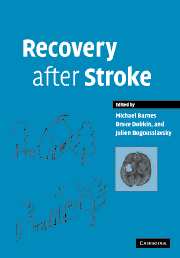Book contents
- Frontmatter
- Contents
- List of authors
- Preface
- 1 Stroke: background, epidemiology, etiology and avoiding recurrence
- 2 Principles of recovery after stroke
- 3 Regenerative ability in the central nervous system
- 4 Cerebral reorganization after sensorimotor stroke
- 5 Some personal lessons from imaging brain in recovery from stroke
- 6 Measurement in stroke: activity and quality of life
- 7 The impact of rehabilitation on stroke outcomes: what is the evidence?
- 8 Is early neurorehabilitation useful?
- 9 Community rehabilitation after stroke: is there no place like home?
- 10 Physical therapy
- 11 Abnormal movements after stroke
- 12 Spasticity and pain after stroke
- 13 Balance disorders and vertigo after stroke: assessment and rehabilitation
- 14 Management of dysphagia after stroke
- 15 Continence and stroke
- 16 Sex and relationships following stroke
- 17 Rehabilitation of visual disorders after stroke
- 18 Aphasia and dysarthria after stroke
- 19 Cognitive recovery after stroke
- 20 Stroke-related dementia
- 21 Depression and fatigue after stroke
- 22 Sleep disorders after stroke
- 23 Technology for recovery after stroke
- 24 Vocational rehabilitation
- 25 A patient's perspective
- Index
11 - Abnormal movements after stroke
Published online by Cambridge University Press: 05 August 2016
- Frontmatter
- Contents
- List of authors
- Preface
- 1 Stroke: background, epidemiology, etiology and avoiding recurrence
- 2 Principles of recovery after stroke
- 3 Regenerative ability in the central nervous system
- 4 Cerebral reorganization after sensorimotor stroke
- 5 Some personal lessons from imaging brain in recovery from stroke
- 6 Measurement in stroke: activity and quality of life
- 7 The impact of rehabilitation on stroke outcomes: what is the evidence?
- 8 Is early neurorehabilitation useful?
- 9 Community rehabilitation after stroke: is there no place like home?
- 10 Physical therapy
- 11 Abnormal movements after stroke
- 12 Spasticity and pain after stroke
- 13 Balance disorders and vertigo after stroke: assessment and rehabilitation
- 14 Management of dysphagia after stroke
- 15 Continence and stroke
- 16 Sex and relationships following stroke
- 17 Rehabilitation of visual disorders after stroke
- 18 Aphasia and dysarthria after stroke
- 19 Cognitive recovery after stroke
- 20 Stroke-related dementia
- 21 Depression and fatigue after stroke
- 22 Sleep disorders after stroke
- 23 Technology for recovery after stroke
- 24 Vocational rehabilitation
- 25 A patient's perspective
- Index
Summary
Introduction
Acute, paroxysmal, recurrent, transient, permanent, progressive, or delayed movement disorders have been occasionally reported in the acute phase of stroke as well as after a delay of up to months or years (Kitanaka et al., 1995; Scott and Jankovic, 1996). Almost any type of hyperkinetic or hypokinetic movement disorder has been reported, most commonly as hemi- or focal dyskinesia. Only isolated case reports or very small series can be found in the literature, and few epidemiological studies (D'Olhaberriague et al., 1995; Ghika-Schmid et al., 1997) have been performed to estimate the prevalence of movement disorders in cerebrovascular disease. However, what is clear in all studies is that any kind of dyskinesia can be found with lesions at any level of the motor frontosubcortical circuits of Alexander et al., (1986), including the sensorimotor cortex, caudate, putamen, pallidum, subthalamic nuclei, thalamus, brainstem and interconnecting pathways (reviewed by Bhatia and Marsden, 1994).
Hypokinetic syndromes
Vascular parkinsonism
Critchley (1929) introduced the concept of arteriosclerotic parkinsonism, characterized by clinical and pathological criteria, but his definition of this “disorder of the pallidal system” with “general rigidity of non-pyramidal type, weakness and slowness of movement” is somewhat different from what is accepted in the definition of the parkinsonian syndrome (requiring at least two items of bradykinesia, tremor, rigidity, and loss of balance or postural responses).
Parkinsonism of vascular origin is a controversial entity. Only 2% of patients with cerebral infarctsmay have a parkinsonian syndrome (Takeuchi et al., 1992). Acute hemiparkinsonism has been recently reported with infarcts in the area of the anterior cerebral artery (Kim, 2001a), large infarcts in the territory of the lenticulostriate arteries, sometimes in association with stereotyped movements (Kulisevsky et al., 1996), and exceptionally, in bilateral vascular lesions of the substantia nigra (Inoue et al., 1997). Subacute or delayed parkinsonism can occur after anoxia (postanoxic parkinsonism is also a well-known entity (Li et al., 2000) but it is rare to happen after a unilateral striatal infarct (Lazzarino et al., 1990).
In the 1960s and 1970s, the concept of vascular parkinsonism was discarded (reviewed by Parkes et al., 1974).
- Type
- Chapter
- Information
- Recovery after Stroke , pp. 259 - 285Publisher: Cambridge University PressPrint publication year: 2005



